It is curious to think that Carmen Herrera and Robert Motherwell were both born in 1915, three years after Jackson Pollock. Pollock died – famously, in a car crash – in 1956, Motherwell at 76 in 1991. Yet the Cuban-born Herrera, at 105, is still making art.
There are other points of convergence and divergence between the three artists. Like Pollock but a decade later, Herrera studied at the Art Students League in Manhattan, a breeding ground for those artists (including her male coevals) who would make up the so-called New York School. Like them, too, Herrera was at the centre of the artistic debates that led to the birth of this school in the late 1940s, prone to the same doubts as Motherwell and Pollock and bolstered by the same certainties. Unlike them, she took what now seems the retrograde step of leaving, in 1948, for Paris, thus deserting the new world capital of modern art for the old.
Central to the debates of that decade was the question of just what, and how desirable, automatism was. The method of working automatically had been brought to America by Parisian Surrealists – Andrés Masson and Breton among them – fleeing the Nazi invasion of France. The technique was at first greedily taken up by young local artists, although such were the times that an animus soon sprang up against it as a European import. To work automatically tout court, wrote Motherwell, was to be enslaved. What was needed was a new, American automatism, in which the fruits of direct access to the psyche might be shaped to a conscious end. Seven decades later, this negotiation between instinct and control is still at the heart of Herrera’s art.
This provenance is, I think, often overlooked because of her great age. Like Louise Bourgeois, Herrera has, in the past 20 years, tended to be considered an artefact as much as an artist – a backhanded honour largely reserved for women, and one unlikely to be accorded to Motherwell were he still working. In fact, she is more simply an artist with an unusually long career, whose roots lie in a historicised time. The Carmen Herrera of 2020 is the Carmen Herrera of 1945, the outcome not of revolution but evolution.
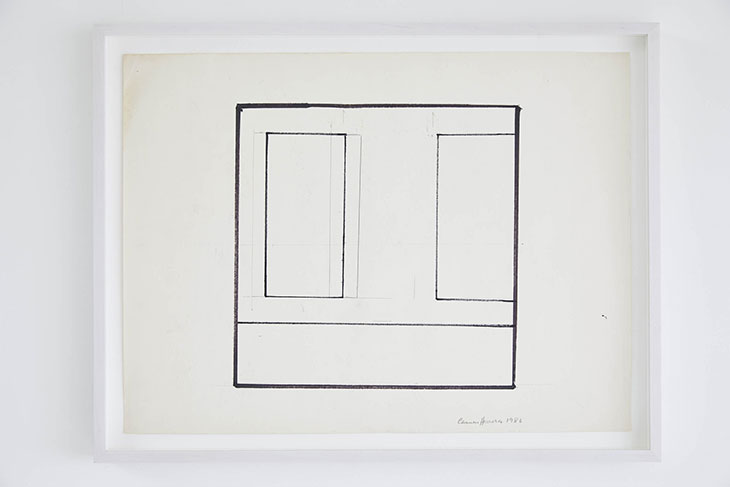
Untitled (1986), Carmen Herrera. Photo: George Darrell. Courtesy Lisson Gallery; © Carmen Herrera
It is worth keeping this in mind as you walk to the top floor of a small but excellent show of her work at the Perimeter, a private exhibition space in Bloomsbury. On the three floors below are a relatively small number of her paintings, eight in all, from the ’80s and ’90s. In this top room, though, are contemporaneous drawings. Among the critical red herrings foisted upon her – age, gender, Latin birth – is the fact that she had trained as an architect before leaving Cuba in 1939. Herrera’s work is thus, predictably, often analysed as architectonic. The drawings in this exhibition show it to be anything but.
Architects work in stable increments, Herrera the opposite. The drawing Untitled (1986), of rectangles within rectangles, shows evident signs of rethinking. The first line – the spontaneous and unmediated one – was clearly found to be unsatisfactory. It was overruled by a firmer, conscious line, describing a rectangle behind which the earlier pentimento sits as a ghost. As Josef Albers was pleased when one of his endlessly repeated Homages to the Square caught him out – when it was, as he said, a Schwindel – so Herrera sees failure as central to her story.
Thus a painting such as Black & Orange (1989), built of meandered shapes. At first sight, these seem stable, tightly chamfered. As often in Herrera’s paintings, though, colour and form work against each other. A slow look at the picture – Herrera’s canvases benefit from slow looking – and the two strong colours begin to pull apart. One of the triumphs of the Abstract Expressionists was to do away with the figure-ground conundrum, Rothko making his ground the figure, Pollock his all-over figures the ground. By contrast, Herrera exploits doubts about which is which – orange on black or black on orange? – and breeds uncertainty from certainty.
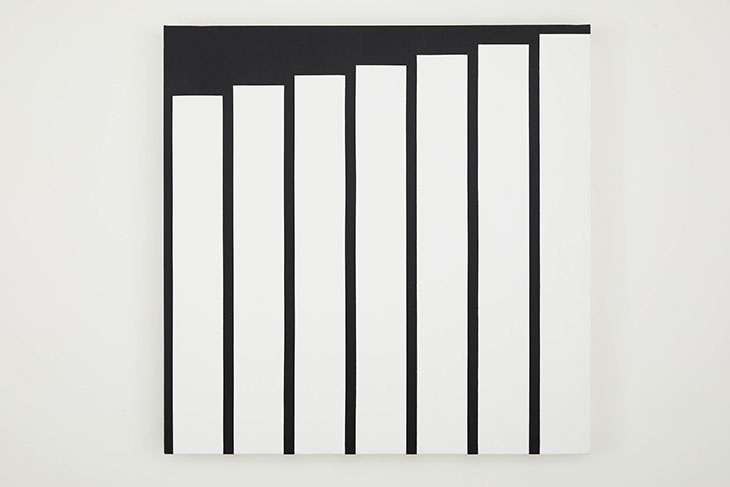
Verticals #2 (1989), Carmen Herrera. Photo: Andy Stagg. Courtesy Lisson Gallery; © Carmen Herrera
So, too, with the titular forms in Verticals #2 (1989), which read as gradated either by height or, in perspectival recession, by depth. In Blue Angle on Orange (1982–83), hung by itself as in a chapel, the inherent instability of a lozenge canvas is at first mitigated by the cobalt blue zigzag running down it, and then exaggerated by the insistence of that same zigzag on being read as travelling from left to right.
Hanging on the wall behind the gallery owner’s desk, visible through a doorway, is another work. This is one of Herrera’s recent sculptures, cantilevered from the wall, made of orange-lacquered aluminium. Until recently, the artist could not afford to make sculpture, other than the occasional piece in plywood. Now, she has used the indignities of her transformation into a phenomenon, a Wonderful Old Thing, by ploughing the resultant financial benefits into her art. The sculpture feels like a fulfilment, the place where the drawings had always been leading. On paper or canvas, the anxiety in Herrera’s work has so far been restricted to two dimensions, its tensions vertical or lateral. Now, at last, her drama can push forward into space. Her work has always been about breakage, and now it has broken through. This might have happened at any time in the past 75 years. It is chance that has allowed it to happen now.
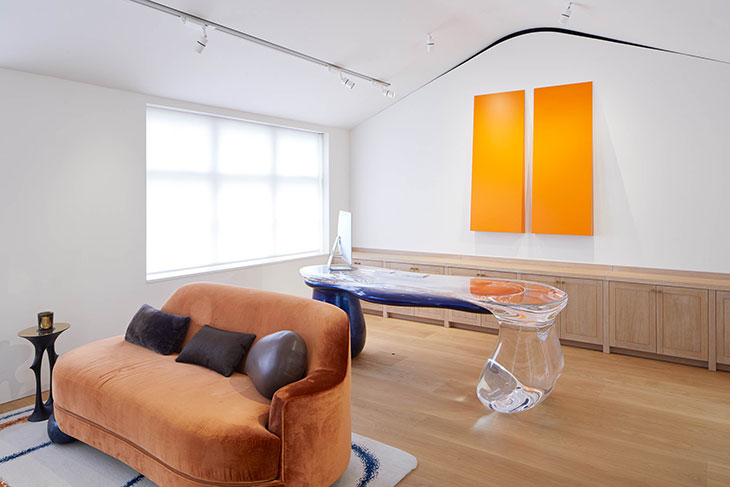
Installation view of Carmen Herrera’s Untitled Estructura (Orange) (2007/2016) at The Perimeter, London, 2020. Photo: Andy Stagg. Courtesy Lisson Gallery; © Carmen Herrera
‘Carmen Herrera: Colour Me In’ is at The Perimeter, London, until 8 January 2021.
Unlimited access from just $16 every 3 months
Subscribe to get unlimited and exclusive access to the top art stories, interviews and exhibition reviews.


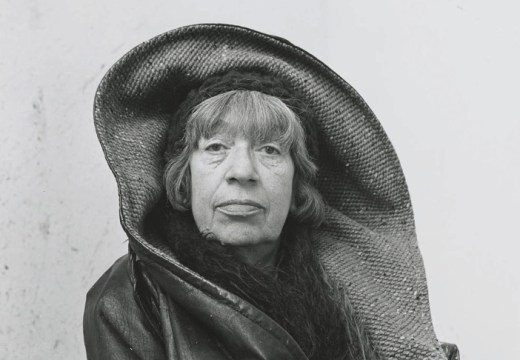
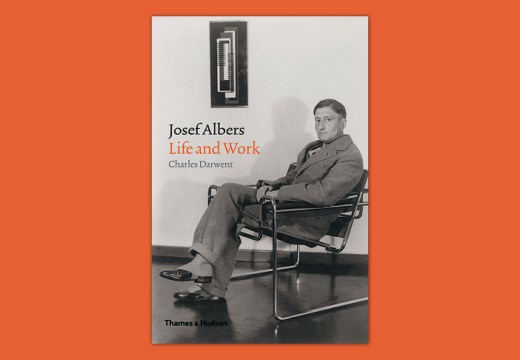
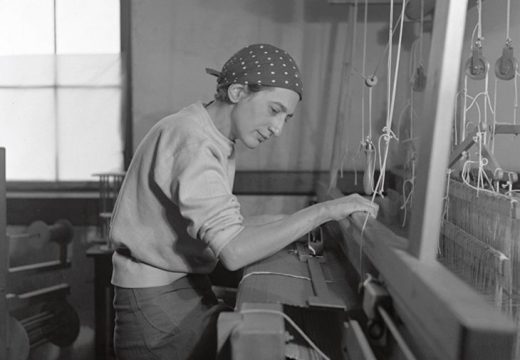









![Masterpiece [Re]discovery 2022. Photo: Ben Fisher Photography, courtesy of Masterpiece London](http://www.apollo-magazine.com/wp-content/uploads/2022/07/MPL2022_4263.jpg)
It’s time for the government of London to return to its rightful home